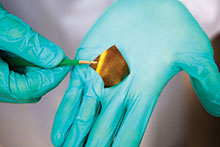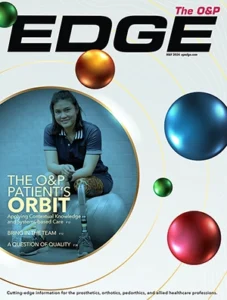
Whether in the brain, heart or other organs-or used for measurements on the skin-these electrodes could be as pliable as the surrounding tissue. They could also be used in displays that can roll up or in the joints of lifelike “soft” robots. Photograph courtesy of Joseph Xu.
Engineering researchers at the University of Michigan (U-M), Ann Arbor, have created a gold-flecked polyurethane conductor that grows its own wires and can conduct electricity even when stretched to more than twice its original length. They say it has implications for gentler medical devices, such as brain-controlled interfaces (BCIs) for prosthetic limbs.
Flexible electronics have a wide variety of possibilities, from bendable displays and batteries to medical implants that move with the body. However, finding good conductors that still work when pulled to twice their length is a tall order. So this team of engineers was surprised that spherical gold nanoparticles embedded in polyurethane could outcompete the best of these in stretchability and concentration of electrons.
“We found that nanoparticles aligned into chain form when stretching,” said Yoonseob Kim, a U-M chemistry doctoral student and first author of the study that was published online in Nature on July 17. “That [configuration] can make excellent conducting pathways.”
To find out what happened as the material stretched, the team took state-of-the-art electron microscope images of the materials at various tensions. The nanoparticles started out dispersed, but under strain, they could filter through the minuscule gaps in the polyurethane, connecting in chains as they would in a solution.
“As we stretch, they rearrange themselves to maintain the conductivity, and this is the reason why we got the amazing combination of stretchability and electrical conductivity,” said Nicholas Kotov, PhD, the U-M Joseph B. and Florence V. Cejka Professor of Engineering and study co-author.
The team made two versions of their material-building it in alternating layers or filtering a liquid containing polyurethane and nanoparticle clumps to leave behind a mixed layer. Overall, the layer-by-layer material design is more conductive while the filtered method makes for extremely supple materials. Kotov and Kim said they chiefly see their stretchable conductors as electrodes.
Brain implants are of particular interest to Kotov. “They can alleviate a lot of diseases-for instance, severe depression, Alzheimer’s disease and Parkinson’s disease,” he said. “They can also serve as a part of artificial limbs and other prosthetic devices controlled by the brain.”
Rigid electrodes create scar tissue that prevents the electrode from working over time, but electrodes that move like brain tissue could avoid damaging cells, Kotov said. “The stretchability is essential during implantation process and long-term operation of the implant when strain on the material can be particularly large.”
Editor’s note: This story was adapted from materials provided by the University of Michigan.




